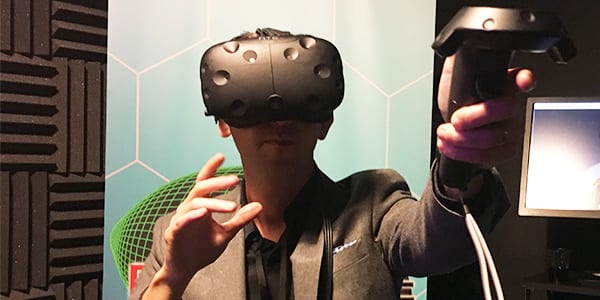 I stepped into the batter’s box at Yankee Stadium with shaky hands and weak knees. Waving the bat above my shoulder, I tried to look the part while Masahiro Tanaka stared down his catcher for the sign. Would he try to blow me away with a mid-90’s fastball? Buckle my knees with a slider? If that wasn’t enough to think about, there was always that devastating splitter. In an instant, there it was: slider, tailing outside. My bat sparked to life and a little bouncer dribbled up the third base line. I made contact! And I might have beaten the throw to first base too… if I wasn’t wearing a virtual reality headset.
I stepped into the batter’s box at Yankee Stadium with shaky hands and weak knees. Waving the bat above my shoulder, I tried to look the part while Masahiro Tanaka stared down his catcher for the sign. Would he try to blow me away with a mid-90’s fastball? Buckle my knees with a slider? If that wasn’t enough to think about, there was always that devastating splitter. In an instant, there it was: slider, tailing outside. My bat sparked to life and a little bouncer dribbled up the third base line. I made contact! And I might have beaten the throw to first base too… if I wasn’t wearing a virtual reality headset.
After my brief battle with Tanaka, I snapped back to reality: a small room in San Francisco, where I had performed before an audience of other techies waiting for their own virtual trip to The House That Ruth Built. This was a VR demo; and what would surely serve me well as a cocktail party ice breaker (“I put a ball in play against Masahiro Tanaka”) was little more than a dream. Truly, VR for sports fans is just that: a dream with a promise we haven’t yet quite fulfilled.
VR today versus where it might take us (virtually) in the future represents a big conundrum for communicators. Many VR companies focus their energy on what’s to come, but leave fans wanting more when today’s experiences don’t measure up. There’s a real risk that fans trying VR for the first time may leave feeling underwhelmed, skeptical and reluctant to take a second look. It’s partly a technology issue, but it’s mostly a communications issue.
Today, six percent of American consumers own VR headsets. VR companies haven’t found their watershed moment that solves the bandwidth issues of present-day networks – we’re all waiting for 5G to solve the world’s data processing problems, but that’s still years away. Continued growth of sports-related VR content, especially the potential of live-streaming, runs into further complications due to complex and often exclusive broadcast rights.
The future of VR in sports is bright, but we don’t live in the future. The sooner we recalibrate the VR discussion to emphasize the immense progress in VR that we’re enjoying today, the sooner we’ll be on the road to more widespread consumer adoption. Today, we can watch breathtaking highlights in VR, like the small collection of near real-time plays Fox offered fans during Super Bowl LI. Today, sports teams are using VR for training purposes. Today, simply put, sports-focused VR is fun.
It’s easy to lose yourself in the fantasy of how the future of VR might manifest for sports fans: jumping into Steph Curry’s jersey and sinking a long three; stepping into Tom Brady’s shoes, calling an audible, and launching yourself into the end zone in the Super Bowl. Most fans don’t have ready access to that experience just yet, and in truth it’s not even particularly close.
And that’s okay, because where we are today is still pretty cool. We just need to step up to the plate and start talking about it that way.



